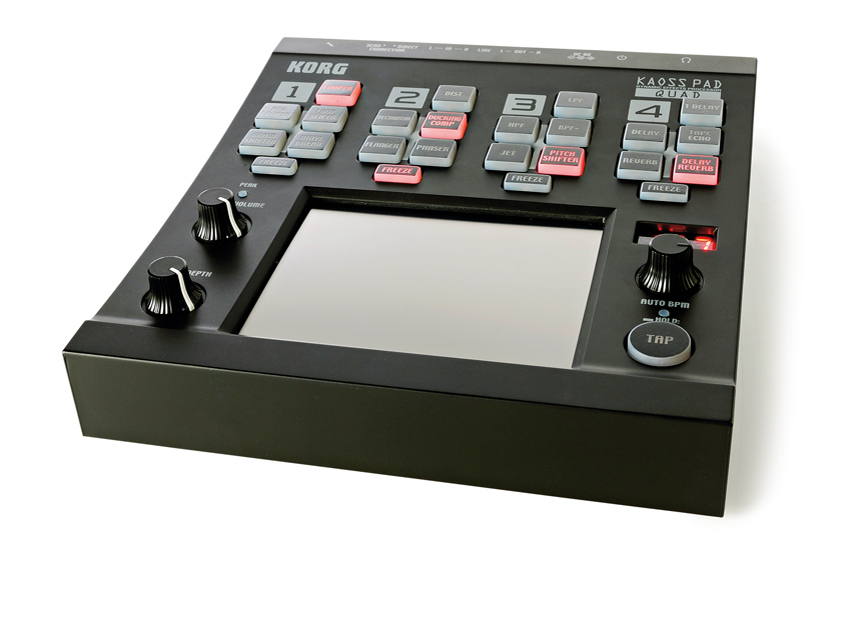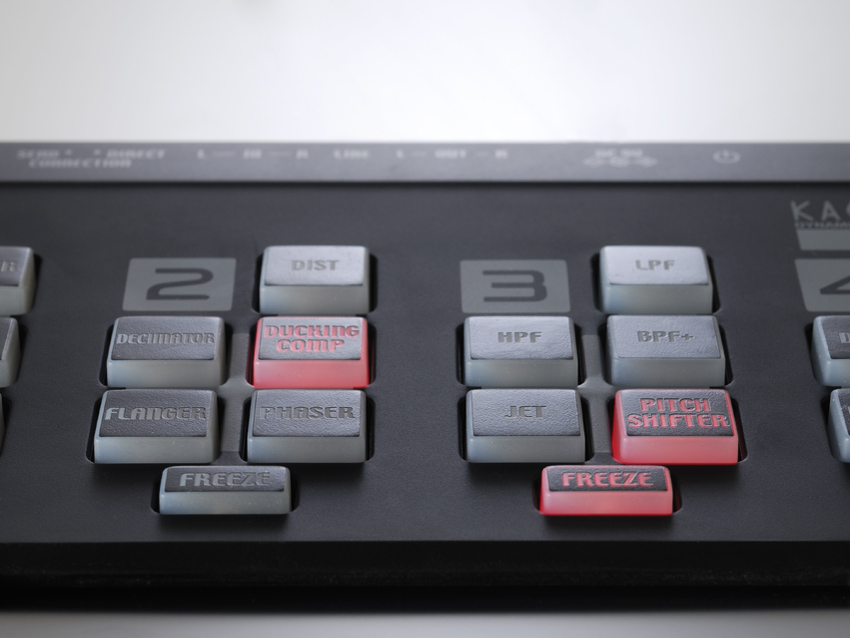MusicRadar Verdict
Lives up to its promise, but is competing too closely with other KPs when it comes to value.
Pros
- +
1.295 different effects combinations. Freeze controls bank. Simple to set up and use.
Cons
- -
No USB or MIDI. Occasionally questionable sound quality.
MusicRadar's got your back

Kaoss Pad Quad

Kaoss Pad Quad

Kaoss Pad Quad
The legacy of Korg's touchy-feely effects boxes is well known, with the first unit spicing up DJ sets and studio sessions way back in 1999.
But it's worth mentioning that this isn't a replacement to the flagship Kaoss Pad 3, but a new model that slots somewhere between the tiny KP Mini and the sampling and looping might that is the Kaoss Pad 3.
"The most fun to be had is to freeze parameters and swap between them like tapping a drum machine."
The main focus here is solely placed on effects, and the ability to achieve multiple combinations of effects and control their parameters fluidly with the touch pad in the usual Kaoss Pad style.
Twenty different effects are included, with the usual suspects such as high, band and low pass filters, distortions, delays, reverbs and modulation effects like flanging and phasing.
These sit among more modern, chaotic loop chopping, slicing and vinyl-style break effects. These are all grouped in their relevant four families on push buttons on the surface of the device.
In sync
Unboxing the unit reveals a thin and light unit that feels quite plastic and not exactly gig-ready. The soft rubber buttons for effects selection and control are more pleasant, brightly backlit and look like they'll suffer a bashing.
Each effect section is in four parts, with a freeze button below to keep each effect at the point you left it on the touch pad if required.
There's the usual FX Depth control allows to feed through a certain percentage of the original signal, and an input volume helps to keep things at the right level.
So really, technically everything is relatively simple. But, this simplicity when you consider the price might raise a few questions.
Although the KP Quad's automatic bpm calculator is fairly accurate and tap tempo can adjust when necessary, when dealing with time sensitive effects like delays, the loop slicer or beat repeat style effects, the lack of MIDI means you can't completely sync 'worry-free' in all situations.
Don't expect the automatic bpm counter to figure out anything mildly complicated, as it seems many times more inaccurate than those present on the standard issue DJ mixers and CDJs.
Quad quandaries
The quality of the effects is fine but classic sounds like the filter and flanging and phasing effects do sound a little thin.
There's a microphone input with quite an aggressive gain control on the rear, but this could work well in a live environment with a DJ or MC, or even more interestingly, to give on stage vocalists touch control over their mic effects.
But as the inputs are phono/ RCA-type connectors, it's not the greatest signal path for that kind of use. In fact the sound quality overall can be questionable if you get the input level to hot.
There is, however, a Peak LED, which will change from amber to red when you're inputting a hot signal. The touch pad has four coloured corners to indicate the weighting given to each effect, glowing brighter as you put your finger nearer.
The instinctive thing to do when using the pad is to swipe around but more often than not, this can make the time-accurate effects quite hard to operate. When using delays, it seems much better to choose a spot on the pad and poke it, rather than swipe around.
With this in mind, it would have been much more useful for the FX depth control to be on a resilient fader rather than the rotary pot so you could quickly cut effects in and out.
Possibly the most fun to be had with this device lies in creating four effects, freezing their parameters then swapping and unfreezing them like you're tapping away at a drum machine.
The trouble is, this still sounds like someone farting around in Ableton or Sugar Bytes Effectrix rather than anything particularly original.
Still it's much more fun working this way and routing synths out of your DAW and through the Kaoss Pad Quad is a great way to chop and effect the sound in fresh ways, creating happy audio accidents for re-editing later.
The Kaoss effect
It's hard to whole-heartedly recommend the Kaoss Pad Quad. Certainly, you will find yourself in awe of the 1,295 different combinations of effects.
Until, that is, you realise that you don't really want to apply a 'distorted reverse-looper-pitch-shifted- reverberated delay' over your entire DJ set and in fact the device is best used, like most things, much more subtly.
It is fun, it keeps all it promises, but the built-in effects on many DJ mixers and software have effectively copied what made Kaoss great and matched it for fidelity and then some. When you factor in the lack of USB, MIDI and balanced outputs you start to question if you really need a Quad.
Overall, it's mixed feelings - there were times when we really enjoyed using the Kaoss Pad Quad, both DJing and in the studio, but as owners of the excellent KP Mini, we have to say that we probably won't miss it when it goes home to Korg.
Future Music is the number one magazine for today's producers. Packed with technique and technology we'll help you make great new music. All-access artist interviews, in-depth gear reviews, essential production tutorials and much more. Every marvellous monthly edition features reliable reviews of the latest and greatest hardware and software technology and techniques, unparalleled advice, in-depth interviews, sensational free samples and so much more to improve the experience and outcome of your music-making.
“Sometimes I am two people. Johnny is the nice one. Cash causes all the trouble. They fight”: How Johnny Cash drew on his own experiences to make his greatest songs
“For those on the hunt for a great quality 12-string electro-acoustic that won’t break the bank, it's a no-brainer”: Martin X Series Remastered D-X2E Brazilian 12-String review
“I have that on more records than anything else”: Take a peek inside Vaughn Oliver’s studio










